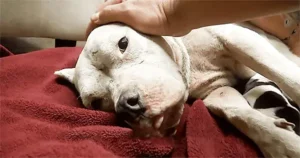Tracheal Collapse is a severe condition affecting dogs’ trachea or windpipe. This condition can cause difficulty breathing, coughing, and other symptoms that can significantly impact the quality of life of your beloved pet. In this article, we will discuss the signs and symptoms of tracheal Collapse in dogs and when to put a dog suffering from tracheal Collapse to sleep.
When a dog is experiencing severe distress, is unable to eat or drink, and can no longer enjoy life, euthanasia may be the kindest option to alleviate their suffering.
However, if the dog can still enjoy life despite their condition, and treatment options such as medication or surgery are helping to manage its symptoms, it may be best to continue providing care for as long as possible.
The decision should be based on what is in the best interest of the dog and its circumstances. Euthanasia should not be seen as a failure but as a final act of love and compassion for a beloved canine companion.
When to put a dog suffering from tracheal Collapse to sleep?

It is recommended to put a dog suffering from tracheal Collapse to sleep if the condition is too advanced. Or the dog‘s overall health is too poor for them to benefit from treatment, and if the dog is not responding well to available treatment options such as medication, oxygen therapy, or surgery.
If the dog cannot breathe comfortably and the coughing and breathing difficulties are frequent and severe, the quality of life for the dog would be significantly affected, and euthanasia may be the kindest option.
Moreover, Factors that should be considered when making the decision include the dog’s overall health, the severity of its symptoms, and how well they respond to treatment. It’s essential to consider the dog‘s ability to eat, drink and interact with their surroundings, walk and move comfortably, and the frequency and severity of coughing and breathing difficulties.
It’s well established that euthanasia should not be seen as a failure but as a final act of love and compassion for a beloved pet. As pet owners, we are responsible for ensuring our pets have a good quality of life and making difficult decisions with their best interests in mind.
What is Tracheal Collapse in dogs?
Tracheal Collapse in dogs is a condition that affects dogs‘ trachea or windpipe. It occurs when the cartilage rings that support the trachea become weak or damaged, causing the trachea to collapse or flatten.
This can make breathing difficult for the dog and lead to other symptoms such as coughing, gagging, and difficulty exercising. Tracheal Collapse is most commonly seen in small-breed dogs, but it can occur in dogs of any size or breed.
Several factors can contribute to the development of tracheal Collapse, including genetics, congenital disabilities, and certain medical conditions such as chronic bronchitis or heart disease. Obesity and exposure to second-hand smoke can also increase a dog’s risk of developing tracheal Collapse.
Symptoms of tracheal Collapse can vary depending on the severity of the condition, but common symptoms include a honking or goose-like cough, difficulty breathing, and exercise intolerance.
Some dogs may also experience coughing, gagging, or coughing up foam. In more severe cases, dogs may have blue or purple gums and tongues, indicating a lack of oxygen.
What are the symptoms of Tracheal Collapse in dogs?

The symptoms of tracheal Collapse in dogs can vary depending on the severity of the condition, but common symptoms include the following:
- A honking or goose-like cough: This is often the first symptom noticed by pet owners and is caused by the Collapse of the trachea.
- Difficulty breathing: Dogs with tracheal Collapse may have difficulty breathing and make noise while breathing.
- Exercise intolerance: Dogs with tracheal Collapse may tire easily and have difficulty exercising.
- Coughing and gagging: These symptoms may occur when the dog is excited, eating, or drinking.
- Coughing up foam: Some dogs with tracheal Collapse may cough up white or yellow foam.
- Blue or purple gums and tongue: In more severe cases, dogs may have blue or purple gums and tongues, indicating a lack of oxygen.
- Rapid breathing or cyanosis: Rapid breathing or cyanosis is a sign of severe tracheal Collapse. It can be a sign of an emergency and should be taken.
- The dog went to the vet immediately.
What causes Tracheal Collapse in dogs?
Tracheal Collapse in dogs is caused by a weakness or damage to the cartilage rings that support the trachea, which leads to the trachea collapsing or flattening. Several factors can contribute to the development of tracheal Collapse, including:
- Genetics: Some breeds of dogs are predisposed to tracheal Collapse, such as small breeds such as Yorkshire Terriers, Pomeranians, and Chihuahuas.
- Congenital disabilities: Some dogs may be born with a congenital disability that makes them more susceptible to tracheal Collapse.
- Medical conditions: Certain medical conditions, such as chronic bronchitis or heart disease, can contribute to tracheal Collapse.
- Obesity: Obesity can put extra pressure on the trachea, making it more likely to collapse.
- Exposure to second-hand smoke: Dogs exposed to second-hand smoke may have an increased risk of developing tracheal Collapse.
- Trauma: Trauma to the trachea caused by injury, blunt force, or accident can cause tracheal Collapse.
How is Tracheal Collapse in dogs diagnosed?

A veterinarian typically diagnoses tracheal Collapse in dogs through a combination of physical examination, radiographs (x-rays), and other diagnostic tests.
During the physical examination, the veterinarian will listen to the dog‘s breathing and may hear a honking or goose-like cough, which is characteristic of tracheal Collapse. They will also look for other symptoms such as difficulty breathing, exercise intolerance, and coughing or gagging.
Radiographs (x-rays) are often used to confirm a tracheal collapse diagnosis. They can show the degree of Collapse and any other changes in the trachea or lungs. The veterinarian may also perform other tests, such as bronchoscopy, which allows them to see inside the trachea and look for signs of Collapse or other abnormalities.
May also perform Blood tests to check for underlying conditions such as heart disease or chronic bronchitis, which may contribute to the tracheal Collapse.
However, the symptoms of tracheal Collapse can be similar to other respiratory conditions. Hence, a proper diagnosis is essential to ensure that the dog receives the appropriate treatment.
What are the treatment options for Tracheal Collapse in dogs?
Treatment options for tracheal Collapse in dogs will depend on the severity of the condition and can include the following:
- Medication: Medications such as bronchodilators and corticosteroids can help open the airways and reduce inflammation, making breathing easier for the dog.
- Oxygen therapy: Oxygen therapy can help increase the amount of oxygen the dog receives, which can help alleviate symptoms.
- Surgery: Surgery such as tracheal stenting, where a small metal or plastic stent is placed in the trachea to help keep it open, may be an option in severe cases.
- Weight management: Weight management and exercise modification may help to alleviate symptoms in cases where obesity is a contributing factor.
- Avoiding irritants: Avoiding exposure to irritants, such as second-hand smoke, dust, and pollen, can help to reduce symptoms.
- Preventive measures include using a harness instead of a collar to avoid pulling on the trachea and using humidifiers to keep the air moist and reduce coughing.
Treatment options are not always effective in all cases, and in some cases, the condition may be too advanced for treatment to be effective. In these cases, euthanasia may be the kindest option to alleviate the dog‘s suffering.
How effective are the treatment options for Tracheal Collapse in dogs?

The effectiveness of treatment options for tracheal Collapse in dogs can vary depending on the severity of the condition and the underlying cause.
Medications such as bronchodilators and corticosteroids can be effective in helping to open the airways and reduce inflammation, making it easier for the dog to breathe. Oxygen therapy can also be beneficial in increasing the amount of oxygen the dog receives, which can help alleviate symptoms.
Surgery, such as tracheal stenting, may be an option in severe cases, but it’s not always effective and may have potential complications. Additionally, surgery is usually only recommended if other treatment options have failed.
Weight management and exercise modification may help to alleviate symptoms in cases where obesity is a contributing factor. Avoiding exposure to irritants, such as second-hand smoke, dust, and pollen, can help to reduce symptoms.
How to manage Tracheal Collapse in dogs at home?
Managing tracheal Collapse in dogs at home will depend on the severity of the condition and the treatment plan recommended by your veterinarian. Here are some steps you can take to help manage your dog’s condition at home:
- Follow your veterinarian’s treatment plan: Follow the plan recommended by your veterinarian, which may include medications, oxygen therapy, and other treatments.
- Keep your dog at a healthy weight: Maintaining a healthy weight can help to reduce the pressure on the trachea and alleviate symptoms.
- Avoid irritants: Avoid exposing your dog to irritants such as second-hand smoke, dust, and pollen, which can worsen symptoms.
- Use a harness instead of a collar: Use a harness instead of a collar to avoid pulling on the trachea.
- Use humidifiers: Use humidifiers to keep the air moist and reduce coughing.
- Provide a calm and quiet environment: Create a calm and quiet environment for your dog to help reduce stress and coughing.
- Regular follow-up visits: Regular visits to the veterinarian to monitor the dog‘s condition and make any necessary adjustments to the treatment plan.
- Be prepared: Be prepared for an emergency. Make sure you know how to recognize the signs of severe distress and learn how to contact your veterinarian in case of emergency.
How to make a dog with Tracheal Collapse more comfortable?

Making a dog with tracheal Collapse more comfortable can involve a combination of different strategies, including:
- Monitoring their activity level: Dogs with tracheal Collapse may tire quickly, so monitoring their activity level and limiting their exercise as necessary is essential.
- Avoiding extreme temperatures: Avoid exposing your dog to extreme temperatures, which can worsen their breathing difficulties.
- Using a leash instead of a collar: Using a leash that attaches to the harness can help reduce pressure on the trachea.
- Providing soft bedding: Provide soft bedding for your dog to sleep on, as this can help to reduce pressure on the trachea and make them more comfortable.
- Offering soft food: Offer soft food to your dog, as this can be easier for them to eat and swallow.
- Providing a comfortable environment: Create a comfortable environment for your dog, with plenty of space to rest and move around.
- Showing extra care and attention: Extra care and attention can help reduce stress and make your dog feel more comfortable.
Remember that while these strategies can help make a dog with tracheal Collapse more comfortable, they may not completely cure the condition.
How to know when it is time to put a dog suffering from Tracheal Collapse to sleep?
The decision to put a dog suffering from tracheal Collapse to sleep should be based on the dog’s quality of life and overall well-being. Factors that should consider include the severity of their symptoms, their response to treatment, and their ability to eat, drink, move comfortably, and interact with their surroundings.
Here are some signs that may indicate it is time to consider euthanasia:
- The dog is experiencing severe distress and can no longer enjoy life.
- The dog is no longer able to eat or drink.
- The dog is in constant pain and discomfort despite treatment.
- The dog’s condition has progressed to the point where it is no longer responsive to treatment.
- The dog’s quality of life has significantly deteriorated, and he can no longer perform basic activities such as walking, eating, or drinking.
- The dog’s suffering outweighs the benefits of keeping them alive.
What are the ethical considerations in putting a dog suffering from Tracheal Collapse to sleep?

The decision to put a dog suffering from tracheal Collapse to sleep involves ethical considerations, as it is a decision that can affect the well-being and quality of life of the dog. Here are some ethical considerations to keep in mind:
- Quality of life: The dog’s quality of life should be the primary consideration. If the dog is experiencing severe distress, cannot eat or drink, and can no longer enjoy life, it may be time to consider euthanasia.
- Relief of suffering: Euthanasia can relieve suffering for a dog in pain or discomfort despite treatment.
- Cost of treatment: The cost of treatment should also be considered, as some treatments may be costly and may not significantly improve the dog’s quality of life.
- Owner’s emotional state: The decision to put a dog to sleep can be emotionally difficult for the owner, and should consider the owner’s emotional state.
- Professional guidance: It’s essential to consult with a veterinarian to understand the full extent of the condition and potential treatment options. They can provide a professional assessment of the dog‘s quality of life and suggest options for treatment or end-of-life care.
- Humane consideration: Euthanasia should always be performed humanely and compassionately, with the dog’s well-being as the primary consideration.
Ultimately, deciding to put a dog suffering from tracheal Collapse to sleep is difficult. It should be made with the guidance of a veterinarian and based on what is in the best interest of the dog’s quality of life and overall well-being. It should also consider the owner’s emotional and financial state.
How to talk to a veterinarian about putting a dog suffering from Tracheal Collapse to sleep?
Talking to a veterinarian about putting a dog suffering from tracheal Collapse to sleep can be a difficult and emotional conversation. Here are some tips on how to have this conversation with your veterinarian:
- Be honest and open: Share your concerns and observations about your dog‘s condition, including any changes in its behavior, appetite, and mobility.
- Ask questions: Ask your veterinarian about the dog’s prognosis, what treatment options are available and what the expected outcomes of each option are.
- Discuss the quality of life: Ask your veterinarian to assess your dog’s quality of life and how it has changed over time.
- Consider the costs: Discuss the costs of treatment options and how they fit into your budget.
- Be prepared for difficult news: Be prepared for the possibility that your veterinarian may suggest euthanasia as the best option for your dog.
- Be respectful: Show respect for your veterinarian’s professional opinion, but don’t hesitate to express your thoughts and feelings about the situation.
- Consider getting a second opinion: If you need clarification on the veterinarian’s recommendation, consider getting a second opinion from another veterinarian.
- Take your time to make the decision: Take the time you need to make a decision that you feel comfortable with, and don’t rush into it.
The conversation with your veterinarian should be collaborative to make the best decision for your dog‘s well-being. It’s good to remember that euthanasia should be seen as a final act of love and compassion for a beloved pet.
How to support a dog with Tracheal Collapse through end-of-life care?

Supporting a dog with tracheal Collapse through end-of-life care can involve a combination of different strategies, including:
- Providing comfort and care: Ensure that your dog is comfortable, with access to soft bedding and a warm and quiet environment.
- Providing good nutrition: Provide your dog with good nutrition, including soft food, and make sure they have access to fresh water.
- Administering medication as prescribed: Administering medicines as defined by the veterinarian can help to alleviate symptoms and improve comfort.
- Showing extra care and attention: Extra care and attention can help reduce stress and make your dog feel more comfortable.
- Maintaining a daily routine: Maintaining a daily routine can provide a sense of stability and normalcy for your dog.
- Spending quality time with your dog: Spend quality time with your dog, talking to them and giving them affection.
- Preparing for the end: Preparing for the back can help you cope better with your dog’s loss. This can include discussing end-of-life care and planning for the future with your veterinarian.
- Grief support: Seek emotional help for yourself and your family during this difficult time.
Note that end-of-life care is about prolonging life and ensuring that the remaining time is as comfortable and peaceful as possible.
How to cope with the loss of a dog suffering from Tracheal Collapse?
The loss of a dog suffering from tracheal Collapse can be a difficult and emotional time. Here are some ways to cope with the loss:
- Allow yourself to grieve: Grief is a natural and personal process; allow yourself to experience and express your feelings.
- Share your feelings with others: Talking about your feelings with friends or family can help ease the grieving process.
- Seek support: Consider joining a support group or talking with a therapist who can help you work through your feelings.
- Please keep your dog‘s memory alive: Create a scrapbook or memory book of your dog’s life, or plant a tree in their memory.
- Reflect on your dog’s life: Reflect on the happy memories and the positive impact your dog had on your life. It can bring comfort during this difficult time.
- Take care of yourself: Take care of yourself physically and emotionally, maintain a healthy diet, and exercise regularly.
- Give yourself time: Give yourself time to grieve. It’s important to remember that the grieving process can take longer than expected.
- Consider getting another pet: After some time has passed, you may decide that you are ready to welcome another pet into your life, but it’s essential to do it at your own pace.
It’s certain that the loss of a pet can be a very emotional and challenging experience, and everyone grieves differently.
Conclusion
Deciding when to put a dog suffering from tracheal Collapse to sleep is a complex and emotional decision that should be based on the dog‘s quality of life and overall well-being. Factors that should consider include the severity of their symptoms, their response to treatment, and their ability to eat, drink, move comfortably, and interact with their surroundings.
It’s essential to consult with a veterinarian to understand the full extent of the condition and potential treatment options and to have an open and honest conversation about your dog‘s prognosis and the available options.
Euthanasia should not be seen as a failure but as a final act of love and compassion for a beloved pet. It can provide relief from suffering for a dog that is in pain or discomfort despite treatment. It’s important to remember that end-of-life care is about prolonging life and ensuring that the remaining time is as comfortable and peaceful as possible.
Losing a pet can be a very emotional and challenging experience, and everyone grieves differently. It’s essential to allow yourself to grieve, seek support, and take care of yourself during this difficult time. The most important thing is to provide love and comfort to your dog during this challenging time and ensure they are not suffering.


